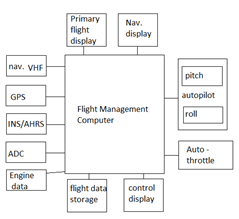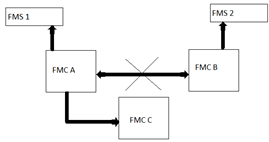This set of Avionics Multiple Choice Questions & Answers (MCQs) focuses on “Flight Management Systems – 1”.
1. Which one of the following is not a function of the FMS?
a) Flight guidance and control of flight path
b) Monitor and regulate speed of the aircraft
c) Automatically switch between different types of communication
d) Automatic control of engine thrust
View Answer
Explanation: The tasks of the FMS include Flight guidance and lateral and vertical control of the aircraft flight path, Monitoring the aircraft flight envelope and computing the optimum speed for each phase of the flight and ensuring safe margins are maintained with respect to the minimum and maximum speeds over the flight envelope, Automatic control of the engine thrust to control the aircraft speed. However, the communication systems are taken care manually by the pilot.
2. What does the following figure represent?

a) Flight Management System
b) Flight Data System
c) Total autopilot system
d) Flight Management Computer
View Answer
Explanation: The above figure represents flight management system. The throttle, Flight Management Computer, Data storage, Navigation and display systems, and the autopilot together is called the FMS.
3. The number of independent FMS in a typical commercial aircraft is?
a) 1
b) 2
c) 5
d) 7
View Answer
Explanation: There are two independent FMS in a typical commercial aircraft’s cockpit. FMS-1 is on the Captain’s side and FMS-2 on the First Officer’s side to carry ou the flight management functions. The reason why both are independent is that when one fails the other can take over.
4. Which of the following is not a way cockpit-flight crew interfaces in the FMS?
a) Primary Flight Display
b) Multi Function Display
c) Keyboard and Cursor Control Unit
d) Target Detection and Locking System
View Answer
Explanation: The cockpit interfaces to the flight crew provided by each FMS comprise a Navigation Display (ND), a Primary Flight Display (PFD), a Multi-Function Display(MFD), a Keyboard and Cursor Control Unit (KCCU) and an Electronic Flight Instrument System (EFIS) Control Panel (EFIS CP).
5. What type of cockpit flight crew interface is used to enter or modify the data on the MFD?
a) Keyboard and Cursor Control Unit
b) Control stick
c) Control Switches
d) Control levers
View Answer
Explanation: The flight crew can navigate through the pages of FMS and can consult, enter or modify the data via the Keyboard and Cursor Control Unit (KCCU). The Keyboard and Cursor Control Unit (KCCU) enables the flight crew to navigate through the FMS pages on the MFD and enter and modify data on the MFD and can also perform some flight plan revisions on the lateral Navigation Display (ND).
6. What control does the EFIS Control Panel provide?
a) Control over graphical and textual FMS data
b) Control over flight plan
c) Control over flight performance
d) Navigation through FMS pages
View Answer
Explanation: The EFIS Control Panel (EFIS CP) provides the means for the flight crew to control the graphical and textual FMS data that appear on the ND and PFD. Control over flight plan and performance is given by MFD. Navigation through the pages is by KCCU.
7. What is the number of Flight Management Computers used in a typical commercial aircraft?
a) 2
b) 1
c) 4
d) 3
View Answer
Explanation: There are a total of three Flight Management Computers FMC -A, FMC -B, FMC -C. They are necessary to carry out the necessary functional computations. They can be reconfigured to maintain the system operation in the event of failures.
8. What operating mode of the FMS does the figure show?

a) Double mode
b) Independent mode
c) Single mode
d) Redundancy mode
View Answer
Explanation: In the Independent Mode, FMS-1 and FMS-2 are both operative, but there is no data exchange between them because they disagree on one or more items such as aircraft position, gross weight, etc.
Sanfoundry Global Education & Learning Series – Avionics.
To practice all areas of Avionics, here is complete set of 1000+ Multiple Choice Questions and Answers.
If you find a mistake in question / option / answer, kindly take a screenshot and email to [email protected]
- Check Aeronautical Engineering Books
- Practice Aerospace Engineering MCQs
- Practice Aeronautical Engineering MCQs
- Apply for Aerospace Engineering Internship
- Check Aerospace Engineering Books
